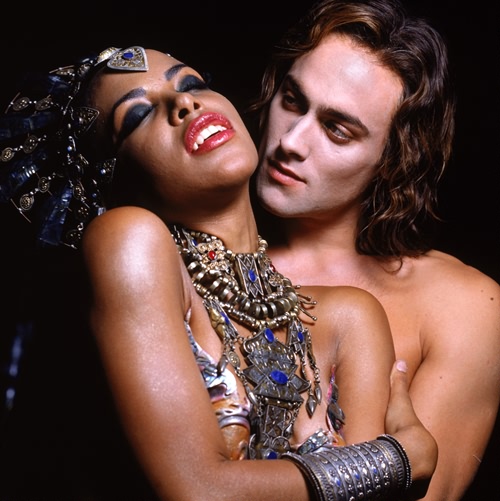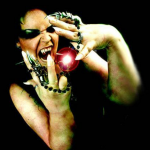There are essentially three roles of women in the vampire world. Women may be victims or vampires themselves. The third level of attachment to the vampire world (VW) is an outside attachment, and that belongs to the women who are mere observers, such as anyone who reads a vampire book and is drawn to it. Though harder to analyze, a woman’s attraction to vampire movies or literature speaks something for the appeal of the vampire in this culture, which this essay series is all about.

Women as Victims
Unfortunately, this the category that the majority of fictional women, as well as those in the ancient and medieval world– where vampires were thought to really exist– fall into. How to approach defining a victim when some women consent, some do not, and some consent only under persuasion, of which vampires are masters of? Well, for the purposes of this essay, I shall define a victim as anyone who serves a vampire, either through meals or companionship or actual servitude. A woman need not always be the blood donor of a vampire to find herself ensnared by him and unable to escape. A vampire’s needs for a companion or servant to help him can be as taxing as being fed from nightly. From the definition of a victim, we can then break it down further to willing and unwilling. But again, due to the arts of a vampire– which I see as being a refined hunting technique– willing and unwilling becomes a blurred line. So we will leave it at this: a willing victim is one who has 1, the ability to leave the vampire’s grasp of influence at any time and 2, the knowledge that he is a vampire, that he is using her, in whatever form as a means of sustaining himself, and despite this knowledge the woman stays anyway and gives herself freely to him. This being defined, assigning characteristics to an unwilling victim is much easier. Even a woman who is coaxed into agreeing to a vampire’s demands does not usually know the full nature of the vampire, nor is she able to escape, precisely because the vampire in question is keeping her under some form of control.
Let’s explore first the willing victim. This victim may have willingly gone to the vampire from the start, or may have been tricked or deluded by the vampire, but eventually was given freedom of choice and chose to stay with the vampire. The character of Anita Blake in Laurell K. Hamilton’s popular “Anita Blake: Vampire Hunter”¹ series is good example of the willing victim. Anita is very clearly not coerced into being a vampire victim. In the first few books she is very hard-nosed concerning her dealings with the vampires; she is unwilling to compromise and unaffected by their hypnotic abilities due to her own inner power. But, over the course of the eight books, she slowly becomes entangled with the Master vampire of the city, becoming his lover and something of a hired thug, keeping all his underling vampires and vampire rivals in line, as well as being pretty persuasive over the wereleopards and werewolves. With such a tough customer, one has to worry if she or the vampire is the victim!
Now, while it may seem that Anita has Jean-Claude wrapped around her finger, and that she is in complete control of the situation, she is, in fact, a victim. Being a vampire hunter leaves her in a precarious situation. Certainly one can’t make enemies out of the entire vampire population, given their great numbers. And allying herself to Jean-Claude has forced her deeper into his debt, more attached to him and most noticeably, he seems to end her up in increasingly desperate situations where she begins to turn into a “monster” herself. Let us look first at how she has wound up in his debt. Master vampires in Hamilton’s book may take a human servant, who become nearly as hard to kill as the vampire himself. To keep the peace and help out her close friends, Anita finds herself slipping further into the dark world of the predators. It eventually comes to the point that Jean-Claude has to make her his human servant to keep her from being killed by those who are of the same element as himself.
After being made a human servant, Anita finds herself drawn in more to the vampire world. While she could renounce herself as his servant, she can not remove the marks that bind her to him. Nor is he very willing to let her appear out of his control, as it sets a bad precedent and makes him look weak to his rivals. However, he’s rather lucky in that Anita is emotionally attached to him and prefers not to have a showdown with him, which everyone secretly believes she could win. But the problem of being tied to a vampire is larger than that for Anita. A Christian, she was raised to believe in the evilness of vampires. Though she herself is an animator (voodoo priestess of sorts), she tries to keep her supernatural abilities out of her life, Unfortunately previous run-ins with bad vampires led her to become a vampire executioner. And as her survival instincts slowly took over, so did her ruthlessness. And being thrust into the dark side of the non-human nature, she finds herself having to kill more and more people, and do it with less forethought and more gut reaction. And the more she kills the more detached she gets from those she is killing. Though as of yet they are all self defense killings, to a degree, she is intelligent enough to realize what she is becoming. Edward, a friend of hers, is a mercenary– a hired gun who would kill anyone for a price. With Edward in her life to act as a mirror, she can see the darkness into which she is descending, loosing her humanity by constantly siding with the “monsters” and fighting in their battles.
As can be seen, Anita falls victim to the VW. Jean-Claude is not the only culprit, but his whole way of life is to blame for changing Anita. While she entered it willing, she seems to be stuck about getting out. Certainly she has the abilities and the potential to kill her vampire “captor” and break free without repercussions, but she does not have the will power. And that lack of initiative stems not from the vampire or any of his tricks, but her own emotions.
Having delved into how a person with either good intentions or willingness (or both) may find herself sinking into a world that is not her own, let us examine those women who are forced into the VW. Mina Harker and Lucy Westenra, from Bram Stoker’s Dracula², are probably the best known– and best recognizable victims of a vampire. I choose to show both women because, though they are both victims, they show two levels of victimization, giving a broader example of the numerous ways a woman can fall prey to a vampire.
Lucy is the first (female) victim that we see in Dracula. Lucy is merely a meal for the Count, who visits her every night, slowing draining away her strength. He has no regard for her as a person or as a potential fledgling vampire. After Lucy’s death, the Count himself takes no action to prevent her from rising from the grave, but leaves her to her own demise. Lucy wanders the moors, mindless, taking children to feed on until Van Helsing and the others lay her to rest permanently. Lucy dies not only in life, but in her vampire afterlife as well. A young woman, she is cut down in her prime, and is left with no hope of surviving as a vampire. Lucy the woman and the vampire both suffer unjustly at the hands of the Count through his cold indifference and negligence.
Mina, on the other hand, is treated very differently than Lucy, who was only a meal ticket for the Count. Mina, for whatever reason, caught the Count’s eye and his fancy, and she became his prize. He expressed wanting to turn her into a vampire as he was so that she could live with him forever. Through falling in love with Mina, the count threatened not only her soul, but her marriage, as well as her way of life. In the early part of the book, Jonathan’s diary shows us the horrible conditions at the castle, and the life-style that the Count lives in. For all his wealth and ancient lands, the Count is feared by the people, hunted, and living in crumbling squalor, even as the modern world slowly encroaches on his ancient ways. If his mistake with Lucy is any indication, the Count would not have been able to survive the transition into the modern world. For all the easy hunting in this new industrial society, devoid of superstition and based in science, in Van Helsing and a few obscure others there are enough to pass around the legends, and eventually even science would come to be questioned should the Count’s vampire offspring grow in number. This is the life he tried to drag Mina into– certain death, even in her vampire state. Luckily for Mina, killing the head vampire, in this case Count Dracula, removes the curse from others, so that she will no longer be at risk for becoming a vampire in her death.
Women as Vampires
Looking at women as vampires makes for a very interesting study. Namely because there aren’t very many. Strangely enough, most vampires are male, including a very high percentage of the lead literary characters. What does this mean for women? Well, it leaves fewer roles open for a vampiress to fill. And what roles may she find herself in? She may be a vampiress fulfilling the whims of a mortal man, or a male vampire. I.e. even as a vampiress the woman may find herself again a victim. She may be a lesbian, where she is almost always in the dominant role in the relationship, as befits her abilities and general vampiric powers. Or she may be a dominant, independent, heterosexual vampiress with male consorts of either mortal or vampiric background. But, there is one little problem; the latter does not exist as far as I have seen. I am not saying that there is no literature that portrays a vampiress in a lead role with male consorts, but the apparent lack has lead me to speculate as to why.
We must first find out what it is about a vampire that makes him or her appealing to a reader. Let’s look at the more popular male vampire character first. Now certainly there is something charming or sexy about almost all male vampires. Lacking these qualities, he’s at least mysterious and hypnotic. Give him any less and he would never be able to hunt effectively. Now, what does he fulfill in a female reader? Certainly women are nearly the complete audience for romance novels. And what is the overwhelming trait of the stud muffins in such books? Sex appeal. Certainly women can enjoy erotic stimulation as much as any man (who has the blatant sex in Playboy and other magazines). But, there are also a lot of men who are fascinated by the vampire. What is in it for him? A male may enjoy the sex appeal of the vampire, but in a different way. For men, the vampire tends to be a fantasy. Here is a vampire that gets all the women, is usually wealthy, dashing, sexy and most importantly, in all of those categories, he is powerful. Does that mean that women enjoy the power as well that is possessed by the vampire? Yes. Does that mean women like to be dominated by men? Certainly not. Though a vampire may be powerful, he rarely needs to force domination. Rather he acts as an outlet for female fantasies of sexual freedom. So we can safely say that both men and women appreciate the heterosexual male vampire.
Now, the other trait lacking in literary male vampires is homosexuality. I have run across a few cases of male vampires being bisexual, for the purposes of mass orgies, but other than those rare instances, male vampires are straight. Seeing as how the modern vampire represents most of society’s sexual urges that they tend to keep repressed, why do we not see more homosexuality in male vampires? I think the main reason is that women have little interest in male homosexuals and that heterosexual men tend to be repelled by blantant homosexuality, though bisexual fantasies certainly get played out in the vampire world, which most men are comfortable with, although it is usually kept repressed. What of homosexual vampiresses? Well, they certainly appeal to homosexual women and bisexual women. This is true of homosexual male vampires appealing to gays and bisexuals. But, as has been pointed out, there is little market for homosexual vampires. While straight men can tolerate bisexuality, out and out homosexuality is too much for most to take. So, why are there lesbian vampiresses? Certainly straight women have as little interest in homosexual vampiresses as straight men have in homosexual vampires. What’s the other factor that makes homosexual vampiresses appealing? Men. Whereas women are not drawn to lesbian vampiresses, men are. For whatever reason, many men fantasize about lesbian women. A friend of mine thought, as I do, that men have an inherent denial of women being able to be homosexuals. Men cannot fathom that a woman can be independent of a male in all things, including sex. Men secretly think that they have “the right stuff” to change a lesbian into a straight woman. So because of this fascination with lesbian vampiresses, men make up a big enough audience to support such literary work, whereas homosexual male vampires play to a much smaller audience.
What does the vampiress victim satisfy in the reader? For women, a vampiress in such a position is no different than a mortal woman, with whom the female reader can identify and long to be. What better thing than to have your sexual fantasies fulfilled every night for an eternity? For the male, a vampiress under heel– as the three wives of Dracula were to him– only furthers the feelings of power, and perhaps even more envy, because a tamed vampiress is certainly a bigger prize than a hypnotised mortal woman.
That leaves us to our final category, and the most difficult one to answer, perhaps. Why are there no dominant, heterosexual female vampiresses? Well, let’s look at our readers once again. Can women really identify with a powerful vampiress, or long to be her? Well, we’ve already come to the conclusion that women like the powerful male vampire because there is something fulfilling in his animalistic tendencies. A male vampire is all about sexual appeal for a woman. So can it really be said that the same women who want to be taken in bed would find a woman who was in control appealing? Not very likely. While women can appreciate the strong, in control woman for being the ideal of feminism, and as something they’d like to be in the workplace, perhaps, the majority of women just don’t want to dominate in the bedroom. Romance novels and fairy tales are built on the basis of men being the protector and the ravisher. Women are taught to rely on more inner strengths and wit. And so you will find that most of your female victims, mortal or not, have some sort of voice. Mina Harker, for instance, was a strong character, and very brave and outspoken for a woman of her time. That is the kind of victim a woman wants to identify with. If a book was solely about a womanizing vampire who had a string of inconsequential female victims, few women would find it appealing. Though a vampire may dominate in sex, he must also be willing to play out to the ideals of a prince charming.
Given that most heterosexual women would not identify with a dominant vampiress, we should look at the other categories. Lesbian women would prefer, I’m sure, to read about homosexual vampiresses, rather than straight ones. As there are books and stories about such, they do not need to turn to the heterosexual, dominant vampiress. That only leaves the men. There certainly are men who like to be dominated, so indisputably a powerful vampiress would appeal to them. But an overwhelming majority of men prefer to be the dominant partner. Just as the homosexual male vampire plays to a very small audience of readers, so does the female dominant vampire only appeal to a certain few.
A curious side question that arises from the study of the female vampire is why, though there is a lack of vampiresses, they are ingrained in our culture. For instance, a vamp is defined as 1. a seductive woman who uses her sexuality to exploit men; 2. to seduce with feminine charms, while the third definition of a vampire is a woman who seduces and exploits men.³ Where do these definitions come from if there is little written about historical vampiresses, and equally few literary vampiresses? Slightly outside of the realm of vampires are the nocturnal creatures called lamia. These creatures are always female and survive by slowly draining away a man’s strength, usually by visiting him in dreams of sexual fantasies. But to get into them is to go off on a completely different tangent, so be on the lookout for additional information on those lusty vamps, the lamias.
Women as an Audience
There’s not much left to say about women as an audience to the VW; most of it was covered in the previous section. The stickier question of why women are drawn to powerful men, domination or general rough sex has to be answered on an individual basis. Personally, I am very drawn to the powerful male vampire not to be dominated so much as to find someone who is sexual, and yet is still chivalrous. Gets so a girl nowadays has to look for a guy that’s over 100 years old to find any of those gallant qualities. The other thing that most vampire males do, for all their controlling, is to be much more aware of how their female partner is feeling. Though a vampire male may be the one to call the shots in the relationship, you very often see him working to make his female victim happy. Excluding the vampires who are real animalistic butchers, killing ruthlessly, you will find male vampires taking care of their victim and seeing that she is pleased, at least sexually. Because a vampire is dependent on mortal blood, an alliance can often be struck that forms a much closer bond than two mortals alone can share. With a symbiotic relationship, both vampire and victim can be drawn very close together, and the relationship can reach a depth not found in the mortal realm, where both partners know in the back of their mind that either could leave anytime they want and be self-sufficient. Perhaps in the vampire we are looking for a greater perfection in our relationships, a closeness and dependency that is lost in a modern society, full of broken homes and t.v. marriages.
¹ “Anita Blake: Vampire Hunter.” By Laurell K. Hamilton. Copyright 1993. Ace Publishing, New York.
² Dracula. By Bram Stoker. Copyright 1981. Bantam Books, New York.
³ Random House Webster’s College Dictionary. Copyright 1992. Random House, Inc., New York.
This essay is seven printed pages.








